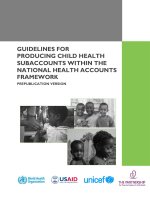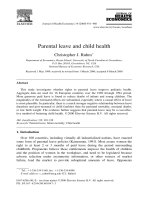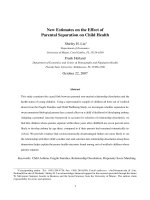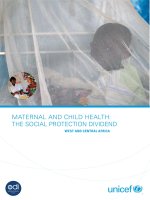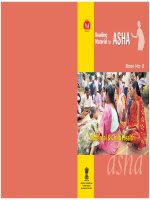INDOOR AIR POLLUTANTS AFFECTING CHILD HEALTH pot
Bạn đang xem bản rút gọn của tài liệu. Xem và tải ngay bản đầy đủ của tài liệu tại đây (335.98 KB, 201 trang )
Indoor Air Pollutants Affecting Child Health
Editor: Alan Woolf, MD, MPH, FACMT
Authors:
Elizabeth Flynn, MD
Paul Matz, MD
Alan Woolf, MD
Robert Wright, MD, MPH
A project of the American College of Medical Toxicology,
funded by a Cooperative Agreement with the
U.S. Agency for Toxic Substances and Disease Registry.
Submitted: November, 2000
2
3
Biosketches
Dr. Elizabeth Flynn received her medical degree from Harvard Medical School
in Boston, and has commenced her pediatric residency at Children’s Hospital,
Boston.
Dr. Paul Matz received his medical degree from the State University of New york
at Buffalo. He completed his pediatrics residency training at the Children’s
Hospital of Philadelphia and is currently in fellowship training at Hasbro
Children’s Hospital and Brown University Medical School, Providence, Rhode
Island.
Dr. Alan Woolf is an associate professor of Pediatrics at Harvard Medical
School, Boston, Massachusetts and a senior associate in medicine at Children’s
Hospital, Boston. Dr. Woolf is the Director of the Program in Clinical Toxicology
at Children’s Hospital and one of two Co-Directors of the Pediatric Environmental
Health Subspecialty Unit at Children’s Hospital. He is also the Director of the
Regional Poison control and Prevention Center Serving Massachusetts and
Rhode Island.
Dr. Robert Wright is an assistant professor of pediatrics at Brown University
Medical School, Providence, Rhode Island and a lecturer in medicine at The
Channing Laboratory at Harvard Medical School, Boston, Massachusetts. He
received his medical degree at the University of Michigan in Ann Arbor and
completed his pediatrics residency at Northwestern University School of
Medicine in Chicago, Illinois. He completed fellowships in both pediatric
emergency medicine (Hasbro Children’s hospital, Providence, RI) and medical
toxicology (Children’s Hospital, Boston) and also has a master’s degree in public
health from the Harvard School of Public Health.
Acknowledgements:
The authors acknowledge the assistance of Mr. Kevin Franck, who provided
library research and referencing support to the project.
4
Indoor Air Pollutants Affecting Child Health
Outline
1.0 Introduction – Alan Woolf
1.1 Scope of Indoor Air Pollution
1.2 Vulnerability of Children to Pollutants
1.2.1 Higher Doses of Xenobiotics
1.2.2 Pulmonary Physiology
1.2.3 Pathogenesis of Lung Disease
1.2.4 Children With Underlying Chronic Illness
1.2.5 Socio-economic Disparities
1.3 Pediatric Environmental Exposures: Points of History-Taking
1.4 Pediatric Physical Examination: Testing for Respiratory
Effects of Indoor Air Pollution
1.5 General Management Considerations
1.6 Building-Related Illness
1.6.1 Symptoms of BRI
1.6.2 HVAC Standards
1.6.3 Etiologies of BRI
1.6.4 Solutions to BRI
1.7 References
2.0 Respirable Particulate Contaminants – Paul Matz
2.1 Physical Characteristics & Sources
2.2 Clinical Effects
5
2.3 Diagnosis
2.4 Control & Prevention
2.5 References
3.0 Asbestos – Alan Woolf
3.1 Epidemiology & Sources
3.1.1 Uses of Asbestos
3.1.2 Workers Contaminating the Home
3.1.3 Exposure During Pregnancy
3.1.4 School Exposures
3.2 Physical Characteristics
3.3 Pathogenesis
3.4 Clinical Effects
3.4.1 Mesothelioma & Pleural Diseases
3.4.2 Bronchogenic Carcinoma
3.4.3 Asbestosis
3.4.4 Other Malignancies & Asbestos
3.5 Diagnosis
3.6 Control & Removal
3.6.1 Inspection
3.6.2 Enclosure
3.6.3 Encapsulants
3.6.4 Abatement
3.7 Prevention
6
3.8 References
4.0 Carbon Monoxide – Alan Woolf
4.1 Epidemiology
4.2 Sources
4.3 Toxicology of Carbon Monoxide
4.4 Clinical Effects
4.4.1 Fetal Effects
4.4.2 Effects on Infants & Children
4.5 Diagnosis
4.6 Treatment of Acute Exposures
4.7 Control & Prevention
4.8 References
5.0 Mercury – Paul Matz
5.1 Sources
5.1.1 Metallic mercury
5.1.2 Inorganic Mercury
5.1.3 Organic Mercury Compounds
5.2 Clinical Effects
5.3 Diagnosis
5.4 Treatment & control
5.5 Prevention
5.6 References
6.0 Volatile Organic Compounds – Paul Matz
7
6.1 Definitions
6.2 Sources
6.3 Clinical effects
6.4 Diagnosis
6.5 Control & Prevention
6.6 References
7.0 Formaldehyde – Paul Matz
7.1 Sources
7.2 Clinical Effects
7.3 Diagnosis
7.4 Control & Prevention
7.5 References
8.0 Indoor Allergens – Robert Wright
8.1 Introduction
8.2 Sources
8.2.1 Dust Mite Allergen
8.2.2 Animal Allergen
8.2.3 Cockroach Allergen
8.2.4 Other
8.3 Clinical Effects
8.4 Diagnosis/Control
8.4.1 Animal Allergen
8.4.2 Dust Mite Allergen
8
8.4.3 Cockroach Allergen
8.4.4 Molds
8.5 References
9.0 Indoor Pesticides – Robert Wright & Elizabeth Flynn
9.1 Scope & Epidemiology
9.2 Exposure Sources
9.3 Pesticides & Social Disparity
9.4 Adverse Health effects –General
9.5 Routes of Exposure
9.6 Specific Toxicities in Children
9.6.1 Neurotoxicity
9.6.2 Insect Repellents
9.6.3 Carcinogencity
9.7 Treatment
9.8 Prevention
9.9 References
10.0 Radon – Alan Woolf
10.1 Physical Characteristics
10.2 Dose & Residential Concentrations
10.3 Natural Sources
10.4 Epidemiology
10.5 Toxicity
10.6 Clinical Effects
9
10.6.1 Pulmonary Effects
10.6.2 Non-Pulmonary Effects
10.7 Radon Detection
10.7.1 Residential Detectors
10.7.2 Residential Radon Levels – U.S.
10.8 Abatement
10.9 Prevention
10.10 Resources & references
11.0 Indoor Molds – Alan Woolf
11.1 Classes of Indoor Molds
11.2 Studies Linking molds with Disease
11.3 Diagnosis
11.4 Prevention
11.5 References
12.0 Environmental Tobacco Smoke – Alan Woolf
12.1 Epidemiology
12.2 Clinical Effects
12.2.1 Fetal Effects
12.2.2 Effects on infants & Children
12.2.2.1 ETS and Immune/Pulmonary Function
12.2.2.2 ETS and Lower Respiratory Tract Disease
12.2.2.3 ETS and Middle Ear Effusions
12.2.2.4 ETS and Childhood Asthma
10
12.2.2.5 ETS and Sudden Infant Death
12.2.2.6 Adolescents and ETS
12.3 Diagnosis
12.4 Carcinogenicity
12.5 Control & Prevention
12.6 References
13.0 Conclusions – Alan Woolf
13.1 Uncertainties and Future Risks
13.2 New Toxins
13.3 Limitations
13.4 Future Directions
13.5 References
11
1.0 Introduction
1.1 Scope of Indoor Air Pollution
Toxins in their environment affect the health of children living in America.
As many as 6 million Americans (25% of whom are under 6 years of age) live
with 5 miles of one of the more than 1500 Federally-designated Superfund toxic
waste sites. The prevalence of asthma in the United States increased by almost
40% from 3.1% of children in 1981 to 4.3% in 1988; asthma hospitalization and
death rates are also higher. (Weitzman et al, 1992; Mannino et al, 1998) This
trend is noticeable in other countries throughout the world (Smith KR, 2000); in
one district in London, the prevalence of childhood asthma increased by 16%
from 1978-1991. (Anderson, 1994) At least part of this increased prevalence is
speculated to result from children’s inhalation of indoor airborne pollutants.
(Jones AP, 1998; Smith KR, 2000)
In the case of some toxins, the threat may not become manifest for years.
Data suggests that radon accounts annually for 10,000-20,000 deaths from lung
cancer in the United States. (Samet and Utell, 1991) Break-outs of building-
induced illness is becoming more common in older schools or those with faulty
heating and ventilation systems. Parental concern about their children’s
exposure to asbestos, lead, indoor pesticides, and other toxins is inevitably
registered with their children’s health care provider. In this review, we examine
various indoor air pollutants affecting the health of children, their clinical effects,
their assessment and management, and strategies for control and prevention.
12
In this monograph we will review some of the major causes of indoor air
pollution, the circumstances of exposure leading to toxic doses of such
pollutants, their toxicology and clinical effects, diagnostic and treatment
strategies for children suffering from these toxic effects, and measures for control
and prevention. The reader is also referred to several excellent reviews of the
health effects of indoor air pollution for more information. (Spengler and Sexton,
1983; Samet, Marbury and Spengler, 1987 and 1988; Angle, 1988; Fernandez-
Caldas, 1995)
Figure 1 shows the relationships between characteristics of the
susceptible child, his or her exposure to toxic agents, and the conducive
environment. Concentrations of indoor air pollutants depend not only on building-
associated sources of emissions and ventilation exhaust patterns, but also
concentrations of pollutants in outdoor air and their migration patterns indoors.
Health effects on children depend on the biologically active dose received in
target tissues, mediated by such host characteristics as host defenses and
activitiy levels. Before considering specific toxic agents and environments
contributing to the health effects of indoor air pollution, we will consider what
makes children particularly vulnerable hosts. We will also add some general
considerations of interest to the clinician with regard to history gathering,
pulmonary function testing, and general management considerations.
13
1.2 Vulnerability of Children to Pollutants
1.2.1 Higher Dose of Xenobiotics
Children differ from adults in many ways: their absorption, metabolism,
and elimination of xenobiotics, their physiology, their proportionately larger dose
of an inhaled toxin, and their higher cumulative risk from toxins over time.
Children, by virtue of their longer life spans, have a higher risk of the
development of cancer from exposure to inhaled carcinogens; the fact that they
spend more than 50% of their time indoors puts them into contact with suspected
carcinogens. Wallace (1991) has estimated the carcinogenic risk of chemicals in
residential indoor air, such as VOCs and pesticides, is equal to the cancer risk of
radon and sidestream tobacco smoke.
The fetus is particularly vulnerable to the transmission of toxins that the
mother inhales through the placent-fetal unit. Certainly maternal smoking puts
the fetus at risk for growth failure and other developmental effects. Air pollutants
to which the mother is exposed in the home or in the workplace are variably
conveyed to fetal tissues, depending on their absorption kinetics and whatever
barrier the placenta might pose. Even noise has been defined as an external
environmental pollutant that can adversely effect fetal development. (AAP, 1994)
The sensitivity of fetal organogenesis and neurodevelopment to perturbations
from xenobiotics is a unique aspect of their risk, as outlined by recent
monographs and books on this topic. (Holladay, 1999; Schettler, 1999)
14
1.2.2 Pulmonary Physiology
Children are at high risk for toxicity from inhaled toxins because of
differences in their pulmonary physiology. They have a higher minute ventilatory
rate (400 mL/min/kg in a newborn vs. 150 mL/min/kg in an adult) than, giving
them higher doses of inhaled toxins relative to adults. Table 2 illustrates the
developmental differences in respiratory rates even within the first two years of
life. The volume of inhaled air also varies widely with activity level; actively
playing or exercising children inhale much greater volumes than those who are
sedentary or asleep. Young infants are obligatory mouth breathers, and many
older infants and children also breath through their mouth more than adults. This
difference in breathing behavior may increase the child’s risk of pulmonary
exposure to respirable particulates and fibers otherwise filtered in the upper
airway.
A higher cardiac pulse rate and extent of tissue perfusion allows for more
rapid exposure to toxins absorbed into the blood. Breathing zones are an
important concept that can predispose a child to certain environmental toxins.
Because a child’s breathing zone is closer to the ground (compared to 4-6 ft. for
an adult), chemicals that are heavier than air (such as mercury) will pose more of
an environmental hazard. For example peak concentrations of air and surface
chlorpyrifos concentrations after Dursban application indoors were substantially
higher (94 ug/m
3
) in infant breathing zones than adult sitting zones (63ug/m
3
),
and remained higher whether or not the rooms were ventilated. (Fenske et al,
1990)
15
1.2.3 Pathogenesis of Lung Disease
Pulmonary defenses to infection include anatomical barriers, mucociliary
pulmonary toilet, secretory IgA and opsonizing IgG, surfactant, complement,
plasma components, vasoactive substances, and cells (macrophages,
polymorphonuclear leukocytes). When these are individually or collectively
compromised by chronic exposure to indoor air pollutants, lower respiratory tract
infections are more likely to develop. (Smith, 2000) The lungs have a limited
ability to respond to toxic insults: irritant, inflammatory reactions (including
bronchospasm), chronic inflammatory reactions (including organization,
remodeling of architecture, and fibrosis), cell-mediated and immediate immune
reactions, and carcinogenesis. (Samet and Utell, 1991) Such reactions may have
exaggerated effects in children by virtue of their immature pulmonary and
immune development. Pediatric lung development occurs in two phases:
pulmonary alveoli and capillary proliferation until the age of 5-8 years followed by
growth through alveolar expansion. Thus infants and children may be more
vulnerable to inflammatory reactions to particulates and potential allergens, for
example, because of their immature lung structure and respiratory defense
mechanisms.
Compared to nonexposed children, those who are exposed to
environmental tobacco smoke experience slower lung development and lower
FEV
1
. (Tager et al, 1983) The combination of exposure to environmental tobacco
smoke and the toxigenic molds, Stachybotrys atra, was possibly associated with
16
an outbreak of acute pulmonary hemorrhage and hemosiderosis in 10 Cleveland
infants in 1993-1994. Furthermore, it was felt that the rapidly growing lungs of
these infants were more susceptible to the inhaled trichothecene mycotoxins
produced by this mold (CEH, AAP, 1998).
Other studies have suggested an increased vulnerability of children to
infections because of immunotoxic changes brought about by inhaled toxins.
Samet and Utell (1991) point out studies of reduced virus killing ability of
macrophages harvested from volunteers exposed to elevated nitrogen dioxide
concentrations vs. those exposed to normal air.
1.2.4 Children with Underlying Chronic Illness
Children with chronic pulmonary diseases such as cystic fibrosis or
asthma are more susceptible to both indoor and outdoor air pollutants
exacerbating their underlying lung dysfunction. The hyperreactivity of children’s
airways compared to adults and their propensity for wheezing as a pulmonary
response to a variety of different environmental triggers may explain in part their
increased risk of asthma. (Etzel, 1995) In one Canadian study of more than
17,600 school children, exposure to environmental tobacco smoke (OR 1.4),
home dampness (OR 1.5), use of gas for cooking (OR 2.0), and use of a
humidifier in the home (OR 1.7) were all associated with physician-diagnosed
childhood asthma. (Dekker, 1991) Within the age group of children 6 years and
younger, those with elevated blood IgE levels and a family history of allergies are
an especially vulnerable group to the onset of wheezing. (Martinez et al, 1995)
17
1.2.5 Socioeconomic Disparities
Because of socioeconomic disparities, more children live in poverty than
do any other age group in America. Their families are more likely to live in public
housing or blue collar neighborhoods in close proximity to industry, with higher
degrees of environmental contamination. For example, people living near air
polluting electricity generating plants have higher rates of asthma and respiratory
illnesses. Benzene, a contaminant of gasoline and a known carcinogen, is a
problem in poverty-ridden, urban settings. Benzene levels correlate with heavy
automobile traffic, and children playing in the streets in poor neighborhoods have
disproportionately high exposures. (Weaver et al, 1996)
Children living in poverty may underutilize health care services and their
asthma and atopic disease may go underdiagnosed. Joseph and her associates
estimated the prevalence of physician-undiagnosed asthma among urban Detroit
school-children in 3
rd
to 5
th
grade to be as many as 14.3%. (Joseph, 1996) In a
cross-sectional study, Crain and her colleagues found the prevalence of asthma
among children living in the Bronx, New York, to be twice the U.S. average, with
higher prevalence rates among both Hispanic and lower income groups within
the sample. (Crain et al, 1994) Others however have suggested that there may
be racial as well as socioeconomic determinants of childhood asthma, with black
children being generally more affected than whites. (Weitzman et al, 1992;
Cunningham et al, 1996)
18
Economic disparities account for racial and ethnic disparities in childhood
lead poisoning, with a disproportionate number of black and Hispanic children
who are exposed to lead-containing dust in older, dilapidated housing stock.
Children in developing countries, living in impoverished settings where wood and
other biomass products are burned indoors for cooking or heating, also have
higher rates of pneumonia and other lower respiratory tract infections. (Smith KR,
2000)
1.3 Pediatric Environmental Exposures: Points of
History-Taking
In taking a history from the parents of a child who is suspected of suffering
the effects of indoor air pollution, health care professionals should emphasize
their inquiry into both the child’s current and previous health. A detailed
environmental history should also be obtained in the assessment. Some of the
specific points of history-taking are included in Table 1.
It is important to include an occupational history. Parents can inadvertently
expose their children to inhaled toxins that they bring home from the workplace
as residual dust on their body or clothing. Large amounts of dust can be
deposited in the home by shaking out used coveralls; instances of increased
rates of mesothelioma affecting family members of asbestos workers are well-
documented. (Grandjean P and E Bach, 1986) Home contamination by lead,
beryllium, asbestos, and other compounds brought into the home by the worker
has been termed “para-occupational disease”. (Knishkowy B and Baker EL,
1986) Thus details of the work habits and behaviors of the child’s caretaker must
19
be gathered. If the parent works in a high risk industry (e.g. smelter; fabrication of
dust-producing materials, battery, pesticide, or chemical manufacturing), how he
or she takes care to change clothes and wash well before returning to the home
are important aspects of the environmental history.
. For all ages, parental observation of the child’s daily experience in the
home setting can provide revealing data to the clinician. A home calendar diary
can correlate symptoms and their severity with other environmental factors
(detectable emissions from nearby waste dumps, exposure to tobacco smoke,
use of the furnace or wood stove).
1.4 Pediatric Physical Examination: Testing for Respiratory
Effects of Indoor Air Pollution
Lung function generally is dependent on linear height, age, and sex. For
the purposely of testing the respiratory effects of indoor air pollutants, children
have been divided into three age categories: those infants less than 2 years,
preschoolers 2-5 years old, and children aged 5 years and older
Several measures of pulmonary function are routinely performed on
infants or children of any age. A simple measure of respiratory rate gives some
information about an infant or child’s degree of respiratory distress, although it is
not a very sensitive measure. Pulse oximetry is useful as an indication of the
adequacy of gas exchange and alveolar function. Radiographs of the chest can
of course be helpful in defining lung pathology, distinguishing such abnormalities
as atelectasis, pneumonia, pneumothorax, interstitial conditions, or changes of
the bronchi or bronchioles consistent with asthma or bronchiolitis.
20
Tympanometry can distinguish the normal air pressure equilibrium
surrounding the tympanic membrane of the ear, and can identify effusions of the
middle ear disrupting the normal pressure pattern in children 2 years and older.
For children 5 years and older, spirometry becomes a most helpful
method of pulmonary function testing. (Samet and Speizer, 1993) Since it
requires voluntary cooperation and uses techniques of forceful expiration;
spirometry is unreliable in younger children. In fact, for many tests of pulmonary
function, normative data for children are quite limited. However measures such
as FVC (forced vital capacity), FEV
1
(forced expiratory volume in 1 second), FRC
(functional reserve capacity), and FEF
25-75%
(mean forced expiratory flow) can
give vital information about lung volumes, the work of breathing, and lung
compliance. Challenges with pharmacologic or physical stimuli of
bronchoconstriction, such as methacholine, histamine, exercise or cold air, can
give data on the patient’s bronchoreactivity. (Samet and Speizer, 1993)
A simple test of reversible obstruction of the airways in children 5 years or
older is the peak expiratory flow rate (PEFR), a test of maximum expiratory air
flow following inspiration to total lung capacity. This test can be performed at
home with an inexpensive hand-held device and can be normed by parents by
keeping a diary of the child’s PEFR at baseline and during wheezing episodes.
Other advanced research tests include aerosolized
99M
Tc-DPTA
(diethylenetriamine pentaacetate plus radioactive tagged Technetium)
scintigraphy and single-breath nitrogen washout. These two procedures assess
injury to pulmonary epithelium and small airways function respectively.
21
Respiratory system mechanics can be measured by a variety of different
manuevers to assess airway obstruction or parenchymal damage. (Metcalf et al,
1994)
1.5 General Management Considerations
Health care providers can help children exposed to environmental toxins
and their families by performing a careful assessment of the issue and how it
might impact on their health. Such an assessment always includes a thorough
history and physical examination. It also includes gathering any medical records
and public records of environmental testing, relevant local ordinances and
regulations, and even media accounts of community actions. Further referrals for
specialized medical assessments, such as neuropsychological and cognitive
testing or pulmonary function testing, may be important in selected cases. Table
5 outlines some general management considerations.
1.6 Building-Related Illness
While the term ‘building-related illness’ (BRI) was first used in regard to
worker complaints of rashes, headaches, dizziness, and other symptoms linked
to workplace pollution, the term has been applied also to students and teachers
who become ill due to poor indoor air quality in schools. Children may spend
much of their day out of the home, in daycare centers, nurseries, or schools,
where they may be exposed to indoor air and other pollutants. Building-related
illness has been linked to volatile chemicals used in cleaning schools, chemicals
22
off-gassing from newly installed floors and carpets, outdated and poorly
maintained ventilation exhaust and air intake systems and antequated HVAC
systems. Water damage to schools can create mold and mildew problems; old
flaking ceiling tiles may expose children to asbestos; and some schools are still
contaminated with lead-containing paints. Children react to indoor air pollution
from building-related causes such as dust mites or molds by wheezing (Etzel,
1995) or with burning eyes, headaches, sore throats, and other irritant
symptoms, depending on other etiological agent(s).
Apter and her colleagues (1994) have suggested that BRI is associated
with any of three factors: i. Inadequate ventilation ii. System complexity and poor
building performance iii. Ventilation systems themselves as a source of pollution.
The reader is referred to recent reviews of building-related illnesses (Menzies
and Bourbeau, 1997; Apter et al, 1994) and resources from the EPA in the
references for additional information.
1.6.1 Symptoms of BRI
A variety of symptoms are reported by children suffering from BRI. These
are listed in Table 3. While building-related illness can be produced by many
causes, often the single specific entity making students sick at a particular school
cannot be identified. There is speculation that most cases arise because the
indoor air concentration of accumulated toxins from any variety of sources rises
above a threshold of noxiousness while the intake and circulation of fresh,
outdoor air decreases.
23
1.6.2 HVAC Standards
Criterion standards for air exchanges (the amount of air circulated through
a building and evacuated completely) set by engineers for the installation of
adequate heating, ventilation and air conditioning (HVAC) units have fallen
through the years, such that exhausts or emissions can linger in the air. HVAC
specifications determine 3 critical functions: i. Intermittent air flow ii. Distribution
of air iii. Building supply and exhaust locations. As energy costs escalated in the
1970s and 1980s, construction of ‘tighter’ buildings coincided with the desire to
reduce the costs of heating and air conditioning in buildings. In some instances
this may have resulted in poor system design and inadequate air exchanges. The
American Society of Heating, Refrigerating, and Air Conditioning Engineers
(ASHRAE) has recommended voluntary ventilation standards from 15-60 cubic
feet minute per person, depending on building-specific uses and activities. (EPA
No. 3, 1990)
Improperly installed or maintained ventilation and exhaust systems have
been implicated in air quality problems in some schools. Fresh air intake vents
near a roadway, for example, may inadvertently draw in motor vehicle fumes.
The neglect of air cleaners and furnace filters and dusty, poorly cleaned ductwork
can exacerbate the problem.
The measurement of carbon dioxide is the conventional environmental
marker used to insure a building’s adequate ventilation. Carbon dioxide itself can
cause dizziness, fatigue, and drowsiness, but it also serves as a surrogate for
24
other indoor air pollutants. Other gases, such as nitrogen dioxide, sulfur dioxide
and carbon monoxide produced by heating sources, can accumulate in a building
and can cause symptoms if not adequately vented. One recent study explored
the effects of increasing the amount of outdoor air to a building from 20 to 50 ft
3
(1.4 m
3
) per minute per person. (Menzies, 1993) This modification did not affect
worker complaints of symptoms referable to the building’s indoor air, however,
and the authors theorized that perhaps microenvironments with the building, with
varying temperature, relative humidity, and air velocity (each of which has been
separately linked to worker symptoms), might have confounded their results.
1.6.3 Etiologies of BRI
A variety of toxic agents have been implicated in BRI. Table 4 inventories
some of the possible causes of BRI in schools. Microbial colonization of
ventilation systems can spread mold spores or infectious agents such as
Legionella which can make susceptible children ill. The off-gassing of solvents,
finishing chemicals, glues and adhesives from newly installed carpeting, floors,
ceiling tiles, or wallboard and fiberboard can also contaminate air. Volatile
organic compounds are chemicals including formaldehyde, trichloroethylene,
other aldehydes, n-alkanes, terpenes, alcohols and acids which have
physicochemical properties such that they maintain a high volatility and
substantial vapor pressure. (Hodgson et al, 1994) VOCs have been linked to
such symptoms as headache, fatigue, irritqability, and more severe
neuropsychological complaints, although there is little evidence that VOCs can
25
cause frank allergic sensitization. (Hogson, 1994) Acceptable levels of total
VOCs in indoor air are complicated by individual variation in odor thresholds and
‘susceptibility’ but generally range from 250-300 ug/m
3
, with no more than 20%
coming from any individual source. (Hosgson, 1994)
1.6.4 Solutions to BRI
The solutions to BRI are as varied as the causes of the problem. Each
instance must be thoroughly investigated, with a medical evaluation of the
children and adults involved by their health care providers. Environmental
assessments of the school should be coordinated by school officials with the
local health department, state authorities, and other governmental agencies.
Health care providers (and parents) should be supplied with the results of air
quality testing.
Strategies to improve indoor air quality can be directed towards (EPA No
4, 1991):
Pollutant source removal or modification
Increased ventilation rates
Air cleaning
Education and communication
The health care provider can often benefit by a ‘walkthrough’ of the school to
obtain additional information about its HVAC systems and the child’s
environment. Advocacy with school and public health officials on behalf of the
child and his or her family is an important role for the physician, who can
